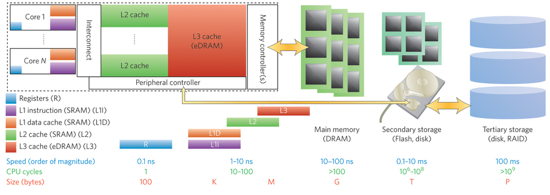Memory Leads Way to Better Computing
New non-volatile memory devices store information using different physical mechanisms.
By Francis Pelletier | March 17, 2015 at 2:53 pmNature Nanotechnology has published an article written by H.-S. Philip Wong, department of electrical engineering and Stanford SystemX Alliance, Stanford University, Stanford, CA, and Sayeef Salahuddin, department of electrical engineering and computer sciences, University of California, Berkeley, CA.
New non-volatile memory devices store information using different physical mechanisms from those employed in today’s memories and could achieve substantial improvements in computing performance and energy efficiency.
Physical distribution and hierarchy of memory in a computer. The lower panel shows speed (as order of magnitude), number of processor (CPU) cycles needed to access the memory, and size of the different memories. RAID, redundant array…
Abstract: “Current memory devices store information in the charge state of a capacitor; the presence or absence of charges represents logic 1’s or 0’s. Several technologies are emerging to build memory devices in which other mechanisms are used for information storage. They may allow the monolithic integration of memories and computation units in three-dimensional chips for future computing systems1. Among those promising candidates are spin-transfer-torque magnetic random access memory (STT-MRAM) devices, which store information in the magnetization of a nanoscale magnet. Other candidates that are approaching commercialization include phase change memory (PCM), metal oxide resistive random access memory (RRAM) and conductive bridge random access memory (CBRAM).”













 Subscribe to our free daily newsletter
Subscribe to our free daily newsletter
